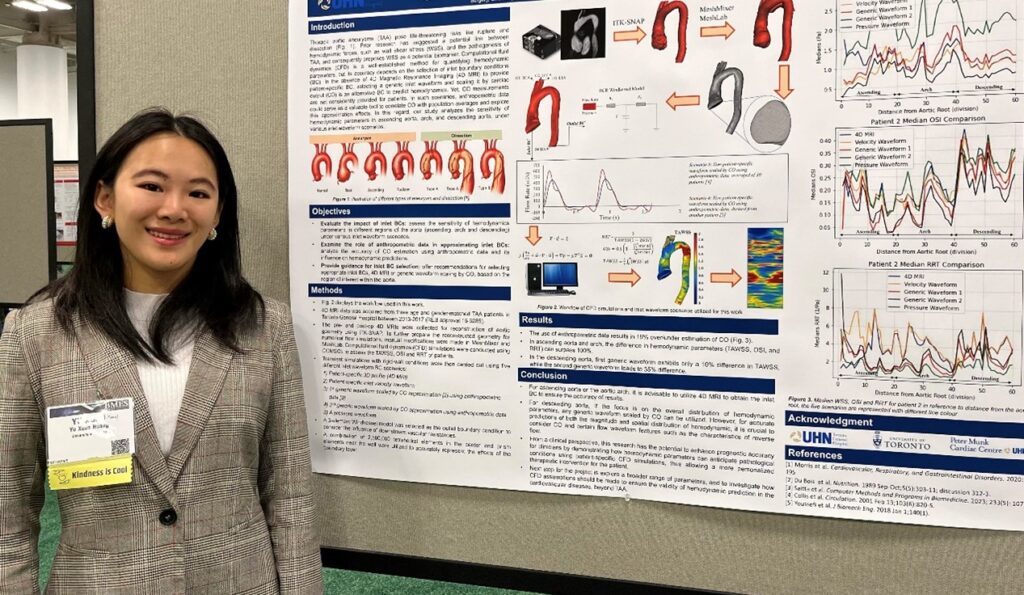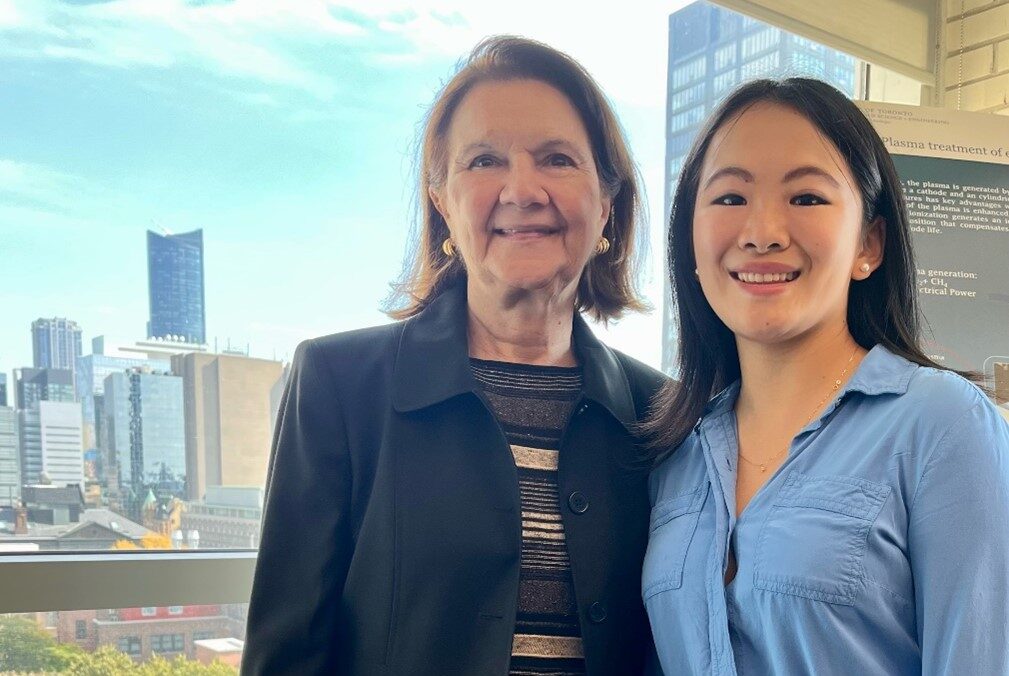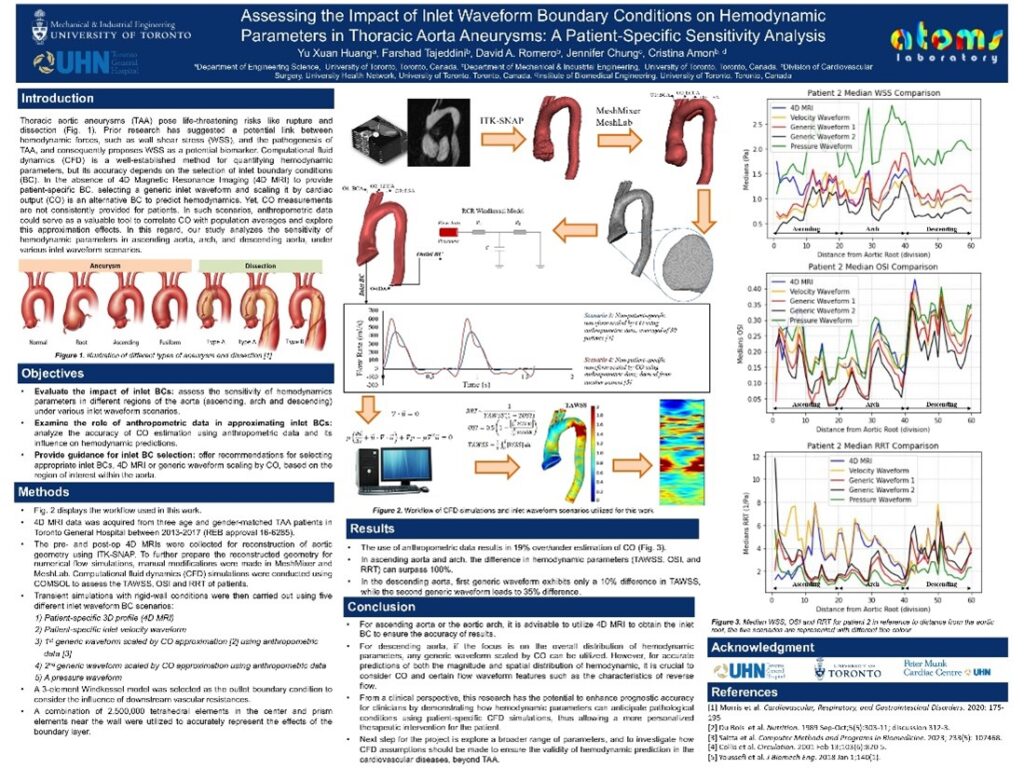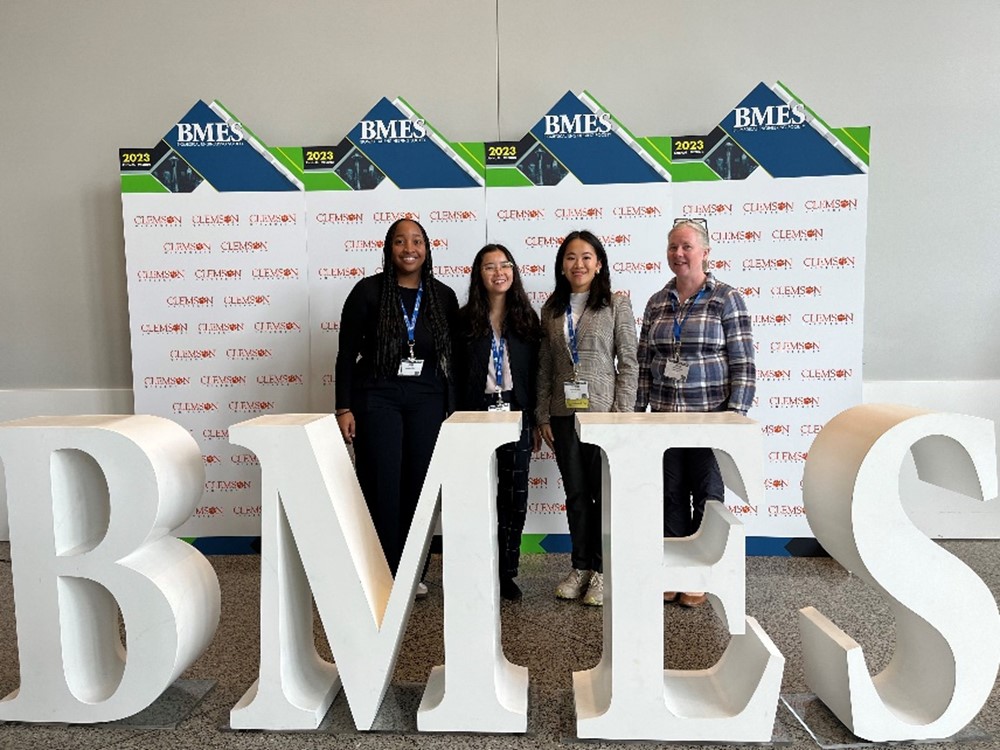
“I’ve known since high school that I wanted to do research,” says Amy Huang (Year 4). “But COVID-19 brought some unforeseen challenges. I had secured a research position at a U of T lab for the summer after my first yearof studies, and a subsequent research exchange at ETH-Zurich in Switzerland for the next summer, but then pandemic lockdowns closed most labs and borders during my first two years in EngSci. My summer research position was cancelled, and I couldn’t travel to work at the Swiss research institution.”
Despite this early disappointment, Huang will graduate in June with several conference posters and presentations and two journal publication already among her accomplishments, thanks to her passion for biomedical engineering and mentors who encouraged her to persevere and explore her interests.
“Exposure to undergraduate research, whether through a summer research placement or the 4th year thesis, is a key feature of the undergraduate experience in EngSci,” says Professor Natalie Enright Jerger, director of the Division of Engineering Science. “It enables students to apply their classroom knowledge, push the boundaries of science and engineering, and crystallize their future career plans by figuring out early on if research is the right path for them.”
Read more about summer research opportunities in EngSci.
Are you researcher interested in hosting students in your lab? Contact Don Newton, EngSci’s Curriculum and Research Officer.
Huang spoke to EngSci to share how she got her research journey started and her advice for younger students.
The pandemic put some logical obstacles in your path, but you’ve gained significant research experience despite that. How did your path unfold?
After my second year of studies, I did a summer internship at Harvard University working on a medical device. Pandemic restrictions were still in place but I was able to work remotely on developing a ‘self-cleaning’ shunt, which is now provisionally patented, for treating hydrocephalus, a neurological disorder where excess fluid builds up in the brains. I already knew then that I wanted to pursue EngSci’s biomedical systems engineering major but this experience confirmed it. Interacting with patients helped me understand how impactful this work can be.
After my PEY Co-op I spent the summer working in the lab of dean emerita, Professor Cristina Amon (MIE), also called the ATOMS Laboratory. It was such a great experience that I asked to continue my research in her lab through my Year 4 thesis project.

What drew you to Professor Amon’s work?
I see summer research as a learning opportunity for me to immerse myself in some of the world-leading research projects here at U of T.
Prior to my summer research, I had some background in computational fluid dynamic (CFD) modeling for medical devices, but primarily in the 2D space.
Knowing that Professor Amon is one of the leading figures in the development of CFD modeling, I came up with the idea to do a summer research project at her lab and broaden my skillsets. Another aspect of Professor Amon’s lab that draws my interest is its diverse spectrum of projects, ranging from tissue engineering, bioreactor development to CFD modeling, in which I definitely see tons of exploration opportunities.
So I wrote her an email to express my interest, and was able to connect with her very quickly. I then got the chance to talk to a few of the graduate students in her lab before settling down on my project where I work on a 3D CFD model.
Tell us a bit about your work.
In cardiovascular simulations, it’s common practice to introduce various assumptions into the models to streamline the simulation process and save time. I want to understand the impact of these assumptions on the accuracy of the simulation results when compared to real patients.
The ultimate benchmark for accuracy in this work is the “4DMRI” scenario , which is precise and specific data directly obtained from the patient. 4D MRI is a medical imaging technique that lets clinicians in visualize blood flow. I used several of the typical assumptions researchers incorporate into their models to see how the models then compared to this benchmark. The result showed that these assumptions are acceptable for simulation of some parts of the aorta but not others.
In the clinical setting, heart simulations are sometimes used to help diagnose cardiovascular diseases. The simulations can provide a valuable surrogate biomarker. Understanding the sensitivity of simulation models to various assumptions not only enhances their efficiency but also helps improve the ability of clinicians to diagnose cardiovascular diseases accurately.

What was it like being part of a research group as an undergraduate student?
It has been a truly transformative experience. On the technical front, it has been a continuous learning journey, gaining experience with software essential for simulation processing and data analysis. The group is very interdisciplinary and I got to hear about many research topics related to CFD from the many graduate students.
However, what sets this experience apart is the exceptional mentorship provided by Professor Amon, who always encourages me to try new ideas in the project and extends her full support to me. She has provided continuous assistance throughout the abstract submission process for conferences and invaluable advice on my graduate school applications.
Of course, the atmosphere within the lab is also highly supportive! During my UnERD presentation in August, I was grateful to have my other mentor, Farshad Tajeddini (MIE PhD student), attend my presentation in person to support me.
Another aspect of the being part of the lab that I appreciate is our direct collaboration with clinicians from the University Health Network (UHN). This has enabled us to tackle real-world clinical challenges where we tailor our research question towards the unmet clinical needs. It truly underscores the vital importance of bridging the gap between research and practical applications in the field of biomedical engineering. The awareness that our work contributes to solving genuine clinical challenges serves as a constant reminder of my role as a biomedical engineer—to make a meaningful impact on the lives of those we aim to help in the healthcare sector.
Since my summer experience was extremely positive and fulfilling, I also pursued my undergraduate thesis in Professor Amon’s lab.
What, if anything, surprised you in your research?
I was actually quite surprised by the lengthy time required to run a CFD simulation. In my case, it typically takes anywhere from 1 to 2 days so I had to plan my time wisely!

You’ve attended conferences to present your research. What was that like?
It was a great experience! At the BMES annual meeting in Seattle I attended several workshops and seminars and got to speak to other researchers from around the world in the cardiovascular biomechanics field. During my poster session I was able to speak to 7-8 groups of people within an hour, sharing research and making connections. And I also got to visit the Seattle Starbucks Reserve with the rest of the U of T team.
Do you have any advice for students who are considering summer research?
This may sound cliché, but it is so important to find what you are passionate about! I would encourage students to talk to your potential supervisor about what you want to do, and what you want to get out of your summer research experience. Also, don’t be afraid to propose new ideas to your supervisor, so that you can help to shape a research experience that truly resonates with your research passion.
I also believe it is important to view your summer research as not just a project but also a mentorship opportunity. Your professors and supervisors (graduate students and postdoctoral fellows) can offer invaluable insights and guidance, especially if you’re considering graduate school or other academic pursuits. Don’t be shy about seeking their advice on matters related to your academic and career trajectory, they can often provide valuable direction and help you navigate the path ahead.
Getting that first research job can be challenging. Don’t get discouraged by obstacles! Don’t be afraid to talk to professors from other engineering disciplines. Undergraduate research is a great change to dip your feet into different pools and find which research area is right for you.
What are your plans for the future?
In May I’ll present a paper at the International Congress of the Canadian Society for Mechanical Engineering as first author. In addition to two journal publications that have already been accepted, I am co-author on one more that we hope to publish this summer.
And I’m looking forward to continuing my research journey with Professor Amon as a MASc student this fall.